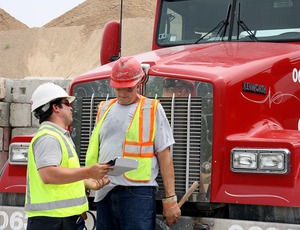
When Paul Ozinga arrives on the jobsite, it doesn't take long for a small crowd of construction workers, superintendents and managers to gather around him. Their excitement isn't because he is bringing lunch or paychecks. It is for his iPad.
Ozinga, 27, has been using the Apple iPad to manage his accounts since the device was introduced last year. With a few taps of his finger, Ozinga can provide his clients with an instant price quote, sign off on a transaction, plan a concrete pour—he even shows superintendents where mixing trucks are stuck in traffic.
“It's almost become a pacifier,” says the co-owner of Ozinga Bros. Inc., a fourth-generation, family-owned ready-mix-concrete business based near Chicago. “In the past, a customer on-site would ask you, 'Where's my truck?' And a typical response you would have to give is, 'It's close by, it has left the plant, it's on the way.' Now, you are not left in the dark.”
The cool factor that a tablet presents makes for great marketing, too, but the main reason why construction professionals like Ozinga are rapidly adopting the technology is due to enhanced productivity in the field. Tablets are offering construction users new ways to speed up communication, obtain client approvals, complete inspections, arrange logistics and manage other complications in a industry that is highly mobile but mocked for its glacial pace of tech adoption.
Although rugged construction tablets have been around for a decade or more, the iPad's swift rise has changed the game. “Construction was always listed as one of the industries that was the furthest behind in innovating in the field,” says Mike Stinson, vice president of Motion Computing Inc., an Austin, Texas-based supplier of business tablets. “It really looks like the tablet may be one of the enabling devices that does allow [the industry] to make that leap forward.”
The iPad is not replacing cell phones and laptops, and it is not the only tablet businesses are using. However, its simplicity and high brand awareness have made it a standard by which other tablets are judged. Paul Auer, a project manager at Neenah, Wis.-based Miron Construction, just wrapped up a $24-million project to build a Salvation Army community center in Green Bay. Its tight, one-year schedule, coupled with multiple layers of approval, made logistics a bear. He distributed iPads to the architect and the owner's managers—all of whom needed to sign off on change orders.
“I needed a solution so that they could look at documents and approve things on the road,” Auer says. “The benefit was that it basically took a one-week process and moved it to one day.”
Tablets are now a tool in just about every business. According to a recent survey, “Enterprise iPad and Tablet Adoption,” sponsored by cloud computing consultant Model Metrics and performed by Dimensional Research, businesses are quickly integrating tablets. But how employees use them is spotty. Most companies lack a clear strategy for mobile computing and experience training lags; decisions among stakeholders can drag out, the survey says. Security and privacy concerns also remain roadblocks.
Even so, the popularity of the iPad as a consumer toy has sped up the adoption rate of tablets as professional tools. “[Workers] don't have time to mess around with every punk kid who comes on the jobsite with a new idea,” explains Julian Clayton, co-founder of Crescent Construction Services LLC, a tablet user. “The entire design of the iPad is [such] that anybody can pick it up and do something with it.”
What makes today's tablets attractive to workers is the same thing that makes them a hit at home, users say.


















Post a comment to this article
Report Abusive Comment